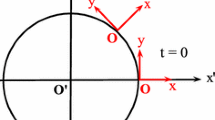Abstract
The analysis of the dynamics of radial movement in different reference frames used in cosmology is made. Use of different frames leads to the difference in inertial forces resulting in different observable effects. The important effect is the appearance in the system different from the synchronous one of the acceleration proportional to the distance analogous to the action of the cosmological constant. Numerical estimate of the difference of this effective cosmological constant and the invariant constant in Einstein equations is made.
Similar content being viewed by others
References
A. Kogut et al., Dipole anisotropy in the COBE differential microwave radiometers first-year sky maps. Astrophys. J. 419, 1–6 (1993). https://doi.org/10.1086/173453
P.D. Naselsky, D.I. Novikov, I.D. Novikov, The Physics of the Cosmic Microwave Background (Cambridge University Press, Cambridge, 2006).
W. Kündig, Measurement of the transverse Doppler effect in an accelerated system. Phys. Rev. 129, 2371–2375 (1963). https://doi.org/10.1103/PhysRev.129.2371
L.D. Landau, E.M. Lifshitz, The Classical Theory of Fields (Pergamon Press, Oxford, 1983).
A.A. Grib, Yu.V. Pavlov, Comparison of particle properties in Kerr metric and in rotating coordinates. Gen. Relativ. Gravit. 49, 78 (2017). https://doi.org/10.1007/s10714-017-2238-3
A.A. Grib, Yu.V. Pavlov, Particle properties outside of the static limit in cosmology. Int. J. Mod. Phys. A 35, 2040044 (2020). https://doi.org/10.1142/S0217751X20400448
A.A. Grib, Yu.V. Pavlov, Particles with negative energies in nonrelativistic and relativistic cases. Symmetry 12, 528 (2020). https://doi.org/10.3390/sym12040528
C.W. Misner, K.S. Thorne, J.A. Wheeler, Gravitation (Freeman, San Francisco, 1973)
S. Weinberg, Gravitation and Cosmology: Principles and Applications of the General Theory of Relativity (Wiley, New York, 1972).
G.F.R. Ellis, T. Rothman, Lost horizons. Am. J. Phys. 61, 883–893 (1993). https://doi.org/10.1119/1.17400
A.A. Grib, Early Expanding Universe and Elementary Particles (Friedmann Lab. Publ, St. Petersburg, 1995).
V. Faraoni, Cosmological apparent and trapping horizons. Phys. Rev. D 84, 024003 (2011). https://doi.org/10.1103/PhysRevD.84.024003
S. Chandrasekhar, The Mathematical Theory of Black Holes (Oxford University Press, Oxford, 1983).
V. Faraoni, G. Vachon, Quasi-geodesics in relativistic gravity. Eur. Phys. J. C 81, 22 (2021). https://doi.org/10.1140/epjc/s10052-020-08808-9
R.C. Tolman, Relativity, Thermodinamics and Cosmology (Clarendon Press, Oxford, 1934).
F. Kottler, Über die physikalischen Grundlagen der Einsteinschen Gravitationstheorie. Ann. Phys. 56, 401–462 (1918). https://doi.org/10.1002/andp.19183611402
G.C. McVittie, General Relativity and Cosmology (Chapman and Hall Ltd, London, 1956).
Planck Collaboration: Planck 2013 results. I. Overview of products and scientific results. Astron. Astrophys. 571, A1 (2014). https://doi.org/10.1051/0004-6361/201321529
B.P. Schmidt et al., The high-Z supernova search: measuring cosmic deceleration and global curvature of the Universe using type Ia supernovae. Astrophys. J. 507, 46–63 (1998). https://doi.org/10.1086/306308
A.G. Riess et al., Observational evidence from supernovae for an accelerating universe and a cosmological constant. Astron. J. 116, 1009–1038 (1998). https://doi.org/10.1086/300499
S. Perlmutter et al., Measurements of \(\Omega \) and \(\Lambda \) from 42 high-redshift supernovae. Astrophys. J. 517, 565–586 (1999). https://doi.org/10.1086/307221
Acknowledgements
The work of Yu.V.P. was supported by the Russian Government Program of Competitive Growth of Kazan Federal University.
Author information
Authors and Affiliations
Corresponding author
Rights and permissions
About this article
Cite this article
Grib, A.A., Pavlov, Y.V. Some effects of different coordinate systems in cosmology. Eur. Phys. J. Plus 136, 318 (2021). https://doi.org/10.1140/epjp/s13360-021-01249-7
Received:
Accepted:
Published:
DOI: https://doi.org/10.1140/epjp/s13360-021-01249-7




